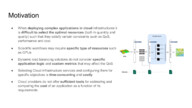 | EasyChair Smart Slide | User Guide/Log in |
| Home |

The IaaS model provides elastic infrastructure that enables the migration of legacy applications to cloud environments. Many cloud computing vendors such as Amazon Web Services, Microsoft Azure, and Google Cloud Platform offer a pay-per-use policy that allows for a sustainable reduction in costs compared to on-premise hosting, as well as enable users to choose various geographically distributed data centers. Using state-of-the-art planning algorithms can help application owners to estimate the size and characteristics of the underlying cloud inveterate. However, it's not always clear which is the optimal solution especially in multi-cloud environments with complex application requirements and \gls{QoS} constraints. In this paper, we propose an open framework named SPIRIT, which allows a user to include cloud infrastructure planning algorithms and to evaluate and compare their solutions. SPIRIT achieves this by allowing users to interactively study infrastructure planning algorithms by adjusting parameters via a graphical user interface, which visualizes the results of these algorithms. In the current prototype, we have included the IaaS Partial Critical Path algorithm. By taking advantage of SPIRIT's microservice-based architecture and its generic interfaces a user can add to the framework, new planning algorithms. SPIRIT is able to transform an abstract workflow described using the CWL to a concrete infrastructure described using the TOSCA specification. This way the infrastructure descriptions can be ranked on various key performance indicators.

















